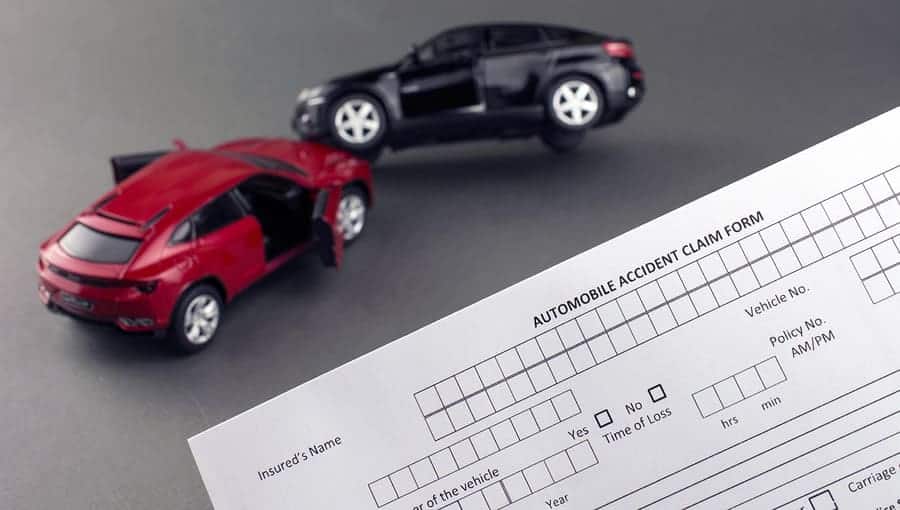Whiplash is common in car accidents, especially rear-end collisions. Your head and neck are forcefully jerked back and forward by the rapid acceleration-deceleration combination, causing injury to the head, neck, and shoulders. Each auto accident is different, and whiplash injuries can range in severity, prompting the use of a grading scale to help understand the nuances of these injuries.
Whiplash is graded on a numerical system from 0-4, with 0 indicating mild injuries and 4 being the most severe. In this article, we’ll explore the factors used to determine the whiplash injury grades, how this grade will affect a settlement based on the whiplash payout scale, and discuss how the settlement process works.
Whiplash Grades
When you’re in an auto accident and sustain a whiplash injury, the pain may be immediate, or it can take some time to completely manifest. The whiplash grading scale creates a way to express the severity of the injury in a universally accepted way. This scale allows medical professionals to treat whiplash effectively and is also used in settlement proceedings to show the severity of the injury.
Whiplash Associated Disorders (WAD)
Whiplash is the physical jerking of the head and neck due to sudden impact, causing kinetic energy transfer, as in an automobile accident. Whiplash Associated Disorders, or WAD, are the injuries and damage your body sustains from the whiplash event. WAD includes damage to your muscles, ligaments, bones (like cervical vertebrae), spinal cord, and nerves. Traumatic brain injuries and concussions also can be classified as WAD if directly caused by whiplash.
The increasing severity directly relates to higher whiplash payouts. In most cases, the grade results in a specific range of settlement values that are assessed along with other factors to reach a settlement value.

Whiplash Grades and Basic Payouts
Grade 0
At this level, no visible signs of injury are present, and a doctor may say that no medical treatment is needed, or you might need to treat the symptoms at home with ice or heat therapy and rest. Often, people will not seek a whiplash payout for this level of injury, but that doesn’t mean you are not hurt. Even if your injury resolves quickly and without complication or you are stiff for a few days at work, you could still be entitled to a payout in the $1,000 – $5,000 range.
Grade 1
Symptoms of pain or soreness are present, but there still may be no visible signs of injuries. Medical treatment is recommended here, and a qualified professional can help you with the symptoms. With grade 1 whiplash, you can experience pain through your neck and shoulders as well as stiffness and some tenderness, which may last for more than a few days. Usually, the recovery time is 10-12 weeks of treatment with a doctor or chiropractor, and there is a possibility you might miss work. Depending on your circumstances, the whiplash payout scale for grade 1 falls in the $5,000 – $10,000 range.
Grade 2
Pain is obvious, as are physical signs of injury with a grade 2 whiplash injury. You will experience some limitations in your range of motion, musculoskeletal injury caused by tears to tendons and ligaments, possible muscle spasms, and some swelling. While there is usually no damage to the cervical spine, medical treatment is required for adequate recovery. Grade 2 whiplash is treated for an average of 28 to 30 weeks and can result in whiplash payouts averaging from $10,000 to $20,000.
Grade 3
Grade 3 whiplash injuries are serious, and end up requiring immediate and ongoing medical treatment. Grade 3 whiplash is significantly more severe and reduces the normal range of motion. Muscle tearing will lead to visible fibrotic scarring in the injured muscles. There is usually swelling and discoloration in the injured area, and neurological problems, including numbness, headaches, loss of sensation, vertigo, and tinnitus, may result. There may be damage to the ligaments supporting the spine, leading to about a year of treatment with a doctor, which may also include physical therapy. Grade 3 average whiplash payouts will be somewhere in the range of $25,000 to $100,000.
Grade 4
The most severe of whiplash injury grades, grade 4 whiplash will result in the largest whiplash settlements. Grade 4 injuries are significant and may need surgery to correct. It is common for cervical vertebrae to be misaligned or fractured with grade 4 whiplash. All the symptoms of grade 3 are present and possibly more pronounced. You also experience a decrease in your reflexes, muscle weakness, and loss of sensation, which usually results in chronic injury, requiring ongoing treatment, possibly for life. The average grade 4 whiplash payout is the highest for any whiplash injury and usually falls between $100,000 and $1,000,000. Whiplash payout for a grade 4 injury may pay even more than depending on the circumstances.
Factors Influencing Payout Scale
The whiplash grade given by a doctor is often the main factor influencing settlement amounts, but other factors also affect whiplash payout, including recovery time, the impact on quality of life, and the severity within the grade.
Recovery Time Needed
The amount of a whiplash settlement is greatly affected by how long you experience pain. Whiplash with a grade of 0 or 1 will usually resolve relatively quickly, taking around 12 weeks for you to feel back to normal. This makes the average payout of grade 1 whiplash settlements lower than the grade 2 average whiplash settlements. Whiplash grades 3 and 4 have a much longer recovery period. Your whiplash payout will be influenced by your medical costs associated with prolonged treatment and the long-term impact recovery time has on daily life.
Severity of Injury
The nature and severity of whiplash injuries are always factors in determining the settlement payout. In most whiplash injuries, the extent of the injuries, especially in the soft tissues of the neck, is not clear right after the accident. The full extent of the car accident victim’s injuries may not become clear for several days, usually in grades 0 and 1. Whiplash injuries that are graded higher can have serious, long-term medical complications. While some insurance companies will write off whiplash claims as a nuisance, in reality, they are actually serious injuries that can cause chronic pain.
If you were in a crash and have experienced the lingering symptoms of whiplash, such as stiffness, pain, reduced mobility, numbness, tingling, and other signs of neck injury, you could be dealing with something closer to a grade 2 or 3 whiplash injury. These injuries will affect you for much longer and can require chronic, lasting treatment. The need for long-term treatment indicates higher grades of injury, so the average whiplash settlement for grades 3 and 4 will include continuing care in many cases. This means more medical bills and a larger whiplash payout for you.
Impact On Daily Living
When your whiplash injury affects your quality of life and inhibits activities done before the injury, your pain and suffering become a factor for whiplash payout. For example, if before the injury, you used to play tennis three times a week, but cannot do so any longer due to an inability to turn your neck properly, your quality of life has been negatively affected, and therefore, this will become a consideration in your settlement. The more you are impacted, the higher the whiplash payout, with injuries resulting in disability receiving a higher minimum whiplash payout.
Whiplash and Concussion
One factor that needs to be considered in addition to the whiplash payout scale is whether a concussion was present with the whiplash injury which could increase the average payout. Because the head snaps back and forth so violently during a car accident, even in a seemingly minor accident, like a low-speed rear-end collision, there’s a very good chance that the brain will actually bang into the inside of the skull, causing a concussion along with the neck injury. With whiplash grades 3 and 4, the payout could even double due to the brain injury.
Find out the maximum compensation you could receive.
Navigating the Settlement Process
In a whiplash settlement negotiation, you will need to take several legal steps to ensure you get as much compensation as possible for your injuries. M Like most injury claims, whiplash claims are usually settled before trial by negotiating out of court. You may not need a lawyer to obtain a fair and equitable whiplash payout.
Documentation is Critical
As with any personal injury claim, you need to keep careful records documenting anything that has to do with your whiplash. Keeping records allows you to negotiate your settlement more quickly, making it hard for an insurance company to dispute. Documentation can include:
- Photos of car accident scene
- Initial diagnosis of injury
- Documentation of any medical procedures
- Treatment plan from a doctor
- Police report
- Any witness statements
- Documentation of lost wages
You’ll need to clearly demonstrate everything with monetary impact and any factors that negatively affect your quality of life. You may even consider keeping a journal to document how things have changed for you. All of these details will impact the amount of your settlement.
Negotiating with Insurance
There are ways to settle your case without hiring a lawyer, and one of those is to send a demand letter to the other party’s insurance company. This is a great choice when your injuries and property damages are less severe and easily proven with documentation. This type of negotiation is also best done when the facts clearly show that the other party in a car accident was at fault or negligent. When you are not at fault, it becomes easier to negotiate with an insurer since the other party caused you injury.
Writing a Demand Letter
When writing a demand letter, you must include the documentation of your whiplash injury and proof of economic and non-economic damages you have suffered. Economic damages include out-of-pocket expenses as a direct result of the accident and injury:
- Cost of doctor visits
- Repairs to your vehicle
- Chiropractic care
- Lost wages from missed work
- Future wages lost due to reduced capacity
- Cost of transportation to and from medical visits
- Other property damages
- Over-the-counter remedies
- Prescriptions
- Projected future medical costs
Anything you can demonstrate with monetary impact are economic damages, which should result in you receiving whiplash payout for as long as it is reasonable and fair. For example, claiming the cost of dog walking services because you were incapacitated is reasonable, but the cost of a new dog is not.
Non-economic damages cover things like pain and suffering or loss of quality of life and can be enormous for someone who has grade 3 or 4 whiplash and has lost the ability to function as they once did. Non-economic damages can be harder to quantify but include situations like emotional or mental anguish caused by the injury.
The final piece of the demand letter is to include a settlement amount appropriate for the facts of your case. The higher the impact the injury has had and the more severe it is, the more compensation you can demand from the other party’s insurance. Ensure the amount is what you genuinely believe you deserve, and don’t get lowballed by the insurance company. You do not have to take an offer if you believe it is unfair, so don’t! Continue negotiation, or you may have to take the matter to court.
Arbitration
Another way to settle is through arbitration, which insurance companies often require as a part of the agreement for them to insure you. Arbitration is a negotiation facilitated by a third, neutral party where you and the insurance company sit down and attempt to reach an agreement. The arbitrator will look at the facts and help the two parties find an equitable middle ground where everyone is satisfied. Insurance may be eager to reach an agreement as they do not want to spend the money to take the case before a judge, so your whiplash grade can be leveraged when you are required to arbitrate a matter.
When sending a demand letter or arbitration fails, it is time to go to court if you still hope to obtain compensation. In this situation, you may want to consider an attorney to help you with a whiplash payout case.
When to Seek Legal Advice
Whether you end up going to court or settling, it’s never a bad idea to talk to a car accident attorney and get a free case evaluation to get a better idea what your case is worth. Most personal injury attorneys will offer a free case evaluation and possibly a free consultation. Speaking with a professional may help you gain insight into your case, even if you do not have to go to court.
Personal Injury attorneys will also offer their work on a contingency. This means you don’t have to pay any money upfront, and a fee is deducted from your settlement upon the completion of your trial. Usually, the fee is a percentage of the total settlement that is decided upon.
Utilizing a free case evaluation can help you gain some insight into the specific circumstances of your case. Knowing what to expect and how things will proceed can calm your worries and make it easier to negotiate your claim. If you need to hire an attorney, pick the one that is right for you, and don’t be afraid to look around and find the best fit.

Conclusion
The payout scale for whiplash will vary, but in most mild to moderate cases, you can expect to receive between $2,500 and $10,000 based on the amount of medical bills, property damage, and lost wages. More serious cases that require extended medical treatment and physical therapy over months can result in a settlement of $30,000 or more.
The Whiplash grade 3 and Whiplash grade 4 payout scale will have significantly higher payouts. When you have injuries that affect the nerves or suffer a concussion, the amount of the settlement you are entitled to can be $100,000 and may even result in compensation of more than $1,000,000.
Remember that with whiplash injuries and the resulting whiplash-associated disorders, there is a significant fluctuation in the amount you may be entitled to. Know how whiplash is graded on a scale of 0-4, and you can navigate your case efficiently. The necessary documentation and a clear whiplash grade will help you obtain a quicker settlement. Because it is the most crucial part of proving that you have received a whiplash injury, the more you understand about the grading scale, the greater your odds of receiving a higher payout.



